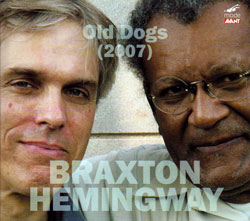
Within the many and variegated strata of situations and structures that Anthony Braxton works, the duet seems to hold particular importance. Specifically it seems to be his favored setting for free improvisation, and seems to give him inspiration for lengthy exploration. There are plenty of examples but two that come to mind for their (shared) singularity of purpose are a pair of four hour meetings recorded in the summer of 2007.
On July 30 and 31, Braxton met with Joe Morris for a morning and an afternoon session each day. The whole of those sessions was released by Clean Feed on the remarkable set Four Improvisations (Duo) 2007. Then, on August 1 and 2 (note that not a day had passed after the Morris recordings), Braxton met for a similar set of four hour-long improvisations, also at Wesleyan University (although in different rooms) and with the same engineer.
The two marathon meetings are quite different, of course, but perhaps in the opposite way than the instrumentation might suggest. While the electric guitar is capable of sounding like just about anything, Morris famously eschews all effects, playing direct to the amplifier. The result in this case is 240 minutes of parallel, converging and conversing lines, lines and more lines like a wicker made of sound. And where the sax/percussion pairing has been codified as a galactic force since the duets of John Coltrane and Rashied Ali, the sessions with Hemingway — recently released as Old Dogs (2007) are richly varied and deeply musical.
In the case of the July sessions, Morris and Braxton had never played together before; an energy of mutual discovery propels the set. Braxton and Hemingway, however, are old chums, old partners, old dogs, then, the latter being the drummer in Braxton's heralded quartet with Marilyn Crispell and Mark Dresser in the 1980s. If the Morris sessions are about discovery, the Hemingway ones are about familiarity. And where the guitarist's focus is through a single output (his playing is complex, but the cable from the jack of his guitar to the input on his amp is simple), Hemingway is an orchestra of percussion. Across the four discs he is heard on kit drums, marimba, vibraphone, steel drums, wood blocks, harmonica, vocals and real-time sampling and electronics. Braxton, for his part, has the full arsenal (sopranino, soprano, C-melody, baritone, bass and contrabass) on hand for both sessions.
But "comfort" in this case doesn't mean "lazy"; it's not uncommon while listening to the set to suddenly realize the players are somewhere very else, and to wonder just how it is they got there. Hemingway seems to push Braxton, or at least to bring out a spirit of invulnerability in him, and it's surprising to hear how much ground even these old masters can cover.
Now to find out what Braxton was up to on August 3.
Comments and Feedback:



More Recent Reviews, Articles, and Interviews @ The Squid's Ear...


|

